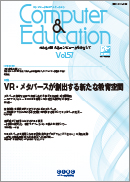Current issue
Displaying 1-14 of 14 articles from this issue
- |<
- <
- 1
- >
- >|
INTERVIEW "Interview with Our New President"
-
2024Volume 57 Pages 3-9
Published: December 01, 2024
Released on J-STAGE: June 03, 2025
Download PDF (1414K)
Special Reports on "Creating New Educational Spaces with VR and Metaverse"
-
2024Volume 57 Pages 12-15
Published: December 01, 2024
Released on J-STAGE: June 03, 2025
Download PDF (2909K) -
2024Volume 57 Pages 16-21
Published: December 01, 2024
Released on J-STAGE: June 03, 2025
Download PDF (1621K) -
2024Volume 57 Pages 22-28
Published: December 01, 2024
Released on J-STAGE: June 03, 2025
Download PDF (1808K) -
2024Volume 57 Pages 29-34
Published: December 01, 2024
Released on J-STAGE: June 03, 2025
Download PDF (2342K)
Research Articles
-
2024Volume 57 Pages 35-40
Published: December 01, 2024
Released on J-STAGE: June 03, 2025
Download PDF (1245K)
Pedagogical Articles
-
2024Volume 57 Pages 41-46
Published: December 01, 2024
Released on J-STAGE: June 03, 2025
Download PDF (1589K) -
2024Volume 57 Pages 47-53
Published: December 01, 2024
Released on J-STAGE: June 03, 2025
Download PDF (1540K) -
2024Volume 57 Pages 54-59
Published: December 01, 2024
Released on J-STAGE: June 03, 2025
Download PDF (3915K) -
2024Volume 57 Pages 60-65
Published: December 01, 2024
Released on J-STAGE: June 03, 2025
Download PDF (1424K)
Research Notes
-
2024Volume 57 Pages 66-70
Published: December 01, 2024
Released on J-STAGE: June 03, 2025
Download PDF (1235K)
Practical Reports
-
2024Volume 57 Pages 71-74
Published: December 01, 2024
Released on J-STAGE: June 03, 2025
Download PDF (1598K) -
2024Volume 57 Pages 75-78
Published: December 01, 2024
Released on J-STAGE: June 03, 2025
Download PDF (1231K)
Editorial Notes
-
2024Volume 57 Pages 99
Published: December 01, 2024
Released on J-STAGE: June 03, 2025
Download PDF (1055K)
- |<
- <
- 1
- >
- >|
